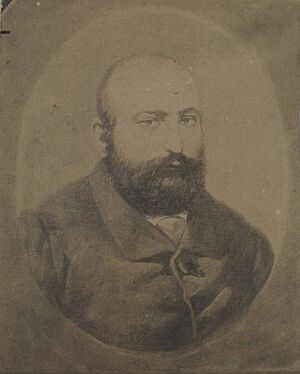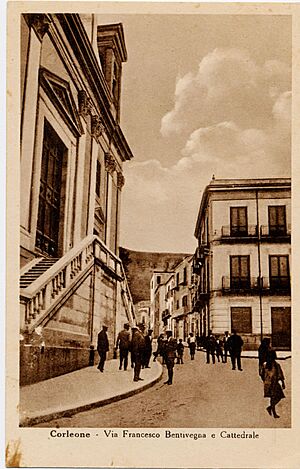Francesco Bentivegna facts for kids
Francesco Bentivegna was an Italian hero born on March 4, 1820. He fought bravely for Sicily's freedom from 1848 to 1856. At that time, Sicily was ruled by the Bourbon family, who were not from Italy. Bentivegna wanted Sicily to be part of a united Italy, free from foreign control. He died on December 20, 1856.
Contents
Francesco Bentivegna's Early Life
Francesco Bentivegna was born in a town called Corleone, Sicily. His parents were Giliberto and Teresa de Cordova. His family was very involved with the Roman Catholic Church. Because of this, his parents hoped he would become a priest.
Fighting for Freedom in Sicily
Francesco Bentivegna first joined the fight against the Bourbon rulers in Palermo in 1848. He showed great courage. The temporary government in charge made him the military leader for the Corleone area. He took the job but refused to be paid for his work.
About 16 months later, the Bourbon forces took control of Palermo again. The Bourbon governor offered to forgive those who had fought against them if they promised loyalty to the French rulers. Bentivegna refused to make this promise. On January 27, 1850, he tried again to lead a rebellion against the Bourbon government in Palermo.
He barely escaped capture and lived for more than two years as a wanted man. During this time, he kept working to organize Italian freedom fighters. He was finally arrested on February 25, 1853, in Palermo. However, he was released on July 25, 1856, before his case could even go to court.
After his release, Bentivegna felt it was the right moment for a big uprising to free Italy from foreign control. In 1856, he worked with another freedom fighter named Salvatore Spinuzza. They tried to start a rebellion among the people. Bentivegna organized groups of farmers to attack towns like Mezzojuso and Villafrati. Spinuzza focused his efforts in Cefalù. A famous Italian leader, Giuseppe Mazzini, promised to help Bentivegna with his group, La Giovine Italia (Young Italy).
Arrest and Execution
Before the 1856 uprising in Mezzojuso could happen, Bentivegna was betrayed. He was arrested on December 2, 1856, while hiding in a house in Corleone. The very next day, he was quickly judged and sentenced to death by a firing squad. His execution happened on December 20, 1856, in Mezzojuso.
Bentivegna's death sentence was based on the charges from his arrest in 1853. But since he had been released without a trial back then, many people believed his execution was unfair. People who saw him before he died said Bentivegna asked for his property to be given to his mother. However, the law at the time said that only male family members could inherit property.
What Happened to His Body?
After he was executed, Bentivegna's body was thrown into a bone pit. But it was secretly and quickly removed and hidden.
On June 23, 1860, Sicily was freed by Giuseppe Garibaldi. After this, Bentivegna's body was brought to Corleone. One year later, his body was wrapped in the Italian flag and buried in a special chapel in Cefalù. This chapel is called San Biagio (St. Blaise). A monument was built there to honor him.



